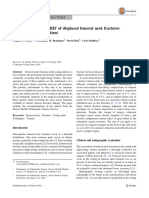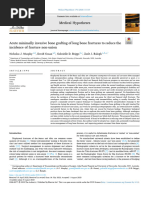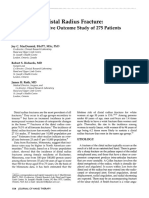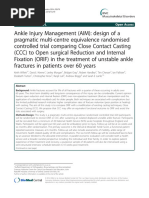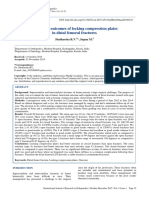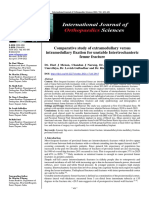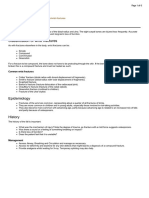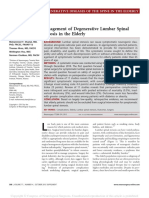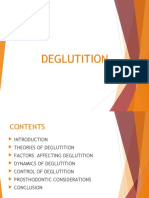Novel Method of Tackling Fracture Non-Union
Novel Method of Tackling Fracture Non-Union
Copyright:
Available Formats
Novel Method of Tackling Fracture Non-Union
Novel Method of Tackling Fracture Non-Union
Copyright
Available Formats
Share this document
Did you find this document useful?
Is this content inappropriate?
Copyright:
Available Formats
Novel Method of Tackling Fracture Non-Union
Novel Method of Tackling Fracture Non-Union
Copyright:
Available Formats
Volume 9, Issue 10, October – 2024 International Journal of Innovative Science and Research Technology
ISSN No:-2456-2165 https://doi.org/10.38124/ijisrt/IJISRT24OCT396
Novel Method of Tackling Fracture Non-Union
Dr. Vinay V Sherlekar
Abstract:- Keywords: Proximal Femoral Nails (PFN), Locking
Compression Plates (LCP), Closed Reduction And Internal
Aim: Fixation (CRIF), Diabetes Mellitus (DM), Hypertension
To evaluate the novel methods in revision surgery to (HTN), And Chronic Kidney Disease (CKD)
tackle non-union fractures of different cases of patients.
I. INTRODUCTION
Background:
Non-union of bone is the body's inability to heal a The femur, or thigh bone, is the longest and strongest
fracture. The most agreed-upon standard definition of bone in the human body. It extends from the hip joint at the
non -union made by the FDA is a fracture that persists for pelvis to the knee joint. It plays a vital role in weight bearing
a minimum of nine months without signs of healing for in the lower extremities. Because of its strength, fracturing
three months. Non-union fractures of femur pose the femur typically requires a big force, as that from a fall or
significant challenges in orthopaedic surgery, often an automobile accident. Femur fractures are classified based
requiring revision procedures to achieve successful bone on the location and pattern of the break, they are; Proximal
healing. In cases where the initial implant has failed, femur fracture, Femoral shaft fracture and Distal femur
innovative solutions are necessary to promote bone union fracture.
and functional recovery.
Femoral shaft fractures, also known as broken
Case Description: thighbone fractures, can occur in the proximal femur and can
The case report presented with four different be classified as spiral or transverse. The proximal segment of
geriatric patients had previously undergone implants the femur is often pulled into flexion and external rotation by
surgery, which subsequently failed to promote bone the psoas muscle and abduction by the abductors. Spiral or
healing. The patients were reoperated using a proximal transverse are the most common types of femoral shaft
femur nail (PFN) and augmented with a locking fractures. Femoral shaft fractures can be caused by trauma,
compressed plate (LCP) to address the non-union. The such as a direct hit to the thigh or an indirect force transmitted
combination of the PFN and LCP along with bone graft through the knee. Orthopaedic physicians treat femur shaft
successfully provided stability to the fracture site, fractures more frequently than any other type of injury. These
promoting bone union, and enabling functional recovery. fractures are potentially fatal and frequently accompany
Radiographic evidence and clinical assessment polytrauma[1]. They frequently arise from high-energy
demonstrated excellent healing progress. events like auto accidents, and if left untreated, can cause
limb shortening and abnormalities. The yearly incidence of
Conclusion: femur shaft fractures ranges from 10 to 37 per 100,000
This case study emphasizes the significance of individuals, peaking in young males at age 27 and older
customized care for non-union femur shaft fractures, women at age 80 [2].
particularly in cases where implant failure has occurred
in the past. When treating difficult non-union fractures, The AO-Müller/Orthopaedic Trauma Association
35mm locking plate and bone graft coupled can be a (AO/OTA) system is widely used to classify femur shaft
useful tool for stabilizing the fracture and promoting fractures. It encompasses the classification of diaphyseal
effective bone healing. femur shafts as well as all long bone fractures. The fracture
patterns are primarily classified into three categories: simple,
Clinical Significances: wedge, and complex fractures[3]. When it comes to treating
This case report exemplifies the need for innovative femur shaft fractures, intramedullary nailing (IMN) is the
and individualized approaches in the management of preferred method due to its low complication rates (4.9%) and
challenging non-union femur fractures. Locking high union rates (72% to 100%) for aseptic non-unions of
compression plates along with PFN and bone graft noncomminuted femoral shaft fractures[4],[5].Nevertheless,
present a viable method, but further investigation and because of the need for repeated surgeries, extended hospital
clinical data are needed to confirm the efficacy and long- stays, and the incapacity to resume regular activities, non-
term results of this strategy. Even with such complex union continues to provide difficulties for orthopaedic
orthopedic settings, successful outcomes can be attained surgeons as well as significant economical difficulties for
via meticulous planning and a patient-centered approach. patients. Non-union of femur shaft fracture has been linked to
Moreover, to prevent revision, the initial treatment must several risk factors, including open fractures, smoking,
be the best. delayed weight bearing, comminution of the fracture site,
instability of fracture reduction, nonsteroidal anti-
IJISRT24OCT396 www.ijisrt.com 767
Volume 9, Issue 10, October – 2024 International Journal of Innovative Science and Research Technology
ISSN No:-2456-2165 https://doi.org/10.38124/ijisrt/IJISRT24OCT396
inflammatory drugs that may interfere with fracture healing, are common indicators of a non-union. There may be
and inadequate nail diameter selection [6]. According to underlying rotational instability or malalignment due to
Weresh et al., the nail locking technique and age were found inadequate fixation or biological healing failure. Clinical
to be highly correlated with the likelihood of healing[7]. examination and radiographic imaging (X-ray or CT scan)
Because this will result in favourable clinical results and an confirmed non-union and mal alignment.
early return to work, it is imperative to comprehend fracture
union in middle-aged patients.
When evaluating patients for studies or treatments
involving femur fracture non-union, particularly in geriatric
patients, it is important to establish clear inclusion and
exclusion criteria to ensure the population is suitable for the
objectives of the study or treatment. Inclusion criteria have
certain characteristics such as age, fracture diagnosis, surgical
history, osteoporosis, rotational instability, consent, and
compliance [8]. Similarly, exclusion criteria have certain
characteristics that would disqualify the patient from
treatment protocol. It includes active infection, pathologic
fractures, severe comorbidities, and past treatment for non-
union fracture.
Minimally invasive surgical techniques offer several Fig 1: X-Ray Showing the Pelvic and Femur Regions with
advantages, particularly for elderly patients with femur PFN Implant
fractures. However, to achieve successful union, addressing
the factors contributing to non-union, such as deforming The management of patient by optimizing healing can
muscle forces, osteoporosis, comorbidities, mobilization be done through glycemic control and careful evaluation by a
status, and nutrition, is vital. A holistic, multidisciplinary cardiologist to ensure the patient is fit for any further surgical
approach is necessary to overcome these challenges and intervention. Since the patient is struggling from non-union is
promote optimal outcomes for geriatric patients. confirmed then potential replacement of failed PFN by
revision surgery and a combination of a Proximal Femoral
II. CASE DESCRIPTION Nail (PFN) with an additional plate of 35mm locking
compression plate (LCP) is considered to enhance fixation
A. Case 1 and address rotational or axial instability. In addition, bone
The case report describes a 72-year-old female graft is done to stimulate the biological healing for bone loss
presented with right hip pain and antalgic gait using a walker or non-union.
for ambulation. The patient also having comorbidities such as
Diabetes mellitus (DM), Hypertension (HTN) and ischemic Post operation monitoring of fracture through radiology
heart disease (IHD). Here is an in-depth detail based on the is conducted on 6 weeks and after 12 months to evaluate the
assessment, clinical findings, and imaging studies. intensity healing and callus formation. The pharmacological
support can be given to the patient based on their age and
The patient had a medical history of proximal femur bone density Bisphosphonates or Denosumab along with
fracture sustained about 8 months ago by treated with a calcium and vitamin D supplemented to support bone health
Proximal Femoral Nail (PFN) in a local hospital. Persistent or treat osteoporosis.
pain, abnormal gait, and delayed or absent healing on X-rays
Fig 2: X Ray Images Showing the Follow Up after Surgery at 6 Weeks (a) and 12 Months(b), (c)
IJISRT24OCT396 www.ijisrt.com 768
Volume 9, Issue 10, October – 2024 International Journal of Innovative Science and Research Technology
ISSN No:-2456-2165 https://doi.org/10.38124/ijisrt/IJISRT24OCT396
Post-operative early mobilization and physiotherapy
will be key to regaining mobility and preventing
complications such as further muscle atrophy or joint
stiffness. Regular monitoring of fracture healing via X-rays
and close attention to blood sugar levels, cardiovascular
status, and physical function.
B. Case 2
This case report describes 67-year-old male who was
treated for an upper-third femur shaft fracture and lost follow-
up for about 9 months after surgery due to the COVID-19
pandemic. The patient presented with complaints of pain in
the right hip and limb shortening. The patient has
hypertension (HTN) and is an alcoholic, both of which are
important factors to manage the current condition. Here is an
outline of the key concerns and potential next steps based on
the provided details:
The possibility of non-union can be resulted from Fig 4: Radiological Examination after 9 Months of Surgery
delayed follow up which leads to limb shortening and pain. Indicating Implant Failure
Other potential complications due to delayed follow up are
hardware failure and avascular necrosis. Although the X-ray Further investigation through X-rays confirmed the non-
shows the internal fixation hardware (an intramedullary nail union femur shaft fracture and the patient was planned to
and screws), the pain and limb shortening could suggest remove the implant and managed with combination of long
possible failure of the hardware. Over time, stress on the PFN with locking compression plate of 3.5mm plates along
hardware could lead to issues, especially if the fracture did with bone graft to stabilize the bone and regenerate fracture
not heal correctly. Whereas pain in the hip after a long period site to heal effectively. After augmentation of LCP with PFN,
of immobility could also point to avascular necrosis, a the patient underwent follow up at 6weeks, 6 months showed
condition where blood flow to the femoral head is intact implants and signs of fracture healing. Final follow-up
compromised, leading to bone death. This is more common at 12 months yielded excellent range of motion in operated
in older individuals and those with a history of alcohol abuse. limb.to evaluate the healing and callus formation.
Fig 3: X Ray Image Showing Post Surgery of Femur Shaft Fig 5: X Ray Image Showing Replacement with Long PFN
Fracture with 3.5mm LCP
IJISRT24OCT396 www.ijisrt.com 769
Volume 9, Issue 10, October – 2024 International Journal of Innovative Science and Research Technology
ISSN No:-2456-2165 https://doi.org/10.38124/ijisrt/IJISRT24OCT396
Fig 6: Post Operative Follow Up at 6 Weeks (a,b), 6 Months(c,d) and One Year(e,f)
If avascular necrosis is present, additional interventions The medical examination of the patient indicates spiral
such as core decompression or even hip replacement surgery femur shaft fracture occurs due to a twisting force, often
may be necessary. A structured rehabilitation plan to help causing a helical or coiled pattern along the length of the
regain mobility and strength, with focus on managing limb bone. This type of fracture typically requires rigid internal
length discrepancy. Optimization of blood pressure control fixation to maintain alignment during healing. The long PFN
and addressing alcohol dependence are essential for used in the surgical repair is a common choice for these types
improving surgical outcomes and overall health. Limb of fractures, offering good biomechanical stability and
shortening after a femur fracture can be addressed in several facilitating early mobilization.
ways, if shortening is significant and causing functional
issues, limb-lengthening procedures can be considered by
surgical correction. Orthotic Devices such as custom shoe
inserts or orthotics can help balance the leg length
discrepancy for smaller differences.
C. Case 3
This case report describes a 67-year-old female patient
with a right lower third spiral femur shaft fracture, who
underwent closed reduction and internal fixation (CRIF) with
a long proximal femoral nail (PFN) in January 2022. The
patient has comorbidities, including diabetes mellitus (DM),
hypertension (HTN), and chronic kidney disease (CKD),
which are important factors to consider in her management
and recovery.
Fig 7: Radiograph Shows the CRIF with PFN in Jan 2022
IJISRT24OCT396 www.ijisrt.com 770
Volume 9, Issue 10, October – 2024 International Journal of Innovative Science and Research Technology
ISSN No:-2456-2165 https://doi.org/10.38124/ijisrt/IJISRT24OCT396
The regular monitoring through X-rays provided the
healing progress of the fracture and showed signs of non-
union and required re-evaluation of the treatment strategy.
Physical examination also helped to assess for signs of
hardware loosening (pain, instability) or complications like
deep vein thrombosis (DVT) or infection. The patient decides
to remove the implant as well as fibrous tissues thereby
enhance the freshening of bone margin. The fracture site is
augmented with locking compression plate of 3.5mm plates
along with bone graft to stabilize the lower femur region and
regenerate fracture site to heal effectively.
Fig 8: Post Operative X Ray Image Showing Implantation of
LCP with Bone Graft
The post operative radiological examination of patient
was followed at 6 weeks and 12 month to evaluate the healing
reported the intact implant and ideal sign for callus formation.
Fig 9: Post Operative Follow Up at Sixth Week (a) and 12 Months(b)
Spiral fractures can sometimes heal slowly, especially The patient persist pain after 8 months suggests
in patients with comorbidities like diabetes and CKD. Since potential complications such as non-union, delayed union,
the patient is having diabetes, will face higher risk for malunion, or hardware failure. These are common issues in
postoperative infections. Regular examination of signs of fractures, especially in the lower third of the femur, where
deep or superficial infections (fever, wound drainage, healing can be slower due to decreased blood supply.
localized pain/swelling) were necessary. Customized Diabetes mellitus (DM) increases the risk of delayed or non-
physiotherapy to strengthen the quadriceps, hamstrings, and union due to impaired bone healing, poor vascularization, and
hip abductors, focusing on improving the range of motion, a higher risk of infection. Hypertension (HTN) needs to be
muscle strength, and gait pattern. As the patient is older and well-controlled perioperatively, especially if revision surgery
likely at risk of falls due to reduced mobility and underlying is required. Osteoarthritis (OA) of the Knee could be
conditions, fall prevention strategies such as home safety contributing to the patient's antalgic gait and pain,
assessments and assistive devices (e.g., walkers) should be complicating the assessment of whether the pain is from the
considered. fracture site, knee arthritis, or both.
D. Case 4 On thorough radiographic evaluation discovered the
A 65-year-old female presented with pain at the fracture current state of fracture, non-union and assessed the condition
site and an antalgic gait with a history of distal femur shaft of hardware. Due to mechanical instability at the fracture site
fracture in the lower third, which operated with closed and persistent stress on an inadequately healing fracture
reduction and internal fixation (CRIF) using an antegrade nail results in screw loosening or nail migration. Concomitant
8 months back. The patient also has known comorbidities, knee osteoarthritis experienced by the patient due to the pain
including diabetes mellitus (DM), hypertension (HTN), and in knee joint and at the fracture site complicated gait and lead
osteoarthritis (OA) of the knee. to difficulty in fully assessing the fracture-related pain.
IJISRT24OCT396 www.ijisrt.com 771
Volume 9, Issue 10, October – 2024 International Journal of Innovative Science and Research Technology
ISSN No:-2456-2165 https://doi.org/10.38124/ijisrt/IJISRT24OCT396
The patient was planned to remove antegrade nail and weight-bearing protocol initiated at 6 week of post operation.
replaced by retrograde nailing approach where retrograde Partial or full weight bearing should do after the confirmed
intramedullary nail is inserted from the knee into the femoral radiographic evidence of healing or after completed callus
canal, providing better stabilization for lower third fractures. formation and it should be under supervision. Followed 1 year
Locking Compression Plates (LCP) can offer angular stability of post operation with the radiological examination which
and may be combined with bone grafting. If there is evidence showed intact implants and signs of fracture healing.
of poor healing, autologous bone grafting or synthetic bone
grafts may be used to stimulate bone healing.
Fig 12: Follow up after One Year Shows Healing Across the
Fig 10: Preoperative X-Rays Showing CRIF using Fracture Line and Alignment
Antegrade Nail in Distal Femur Fracture Leads to Non-
Union III. DISCUSSION
Over time, significant advancements have been made in
the management of non-union femur fractures. Numerous
methods have been reported for the treatment of these
fractures. For the most part, these fractures were treated
conservatively in the early 1900s. The concepts of the newly
formed Arbeitsgemeinschaft fur Osteosynthesefragen (AO)
were not used to treat these fractures until 1970 [9,10]. But
these fractures still present a problem and are challenging to
treat, even with the range of available treatment options.
Although locking plates and retrograde intramedullary nails
are the two most often used fixation techniques for fractured
femurs, neither technique has been shown to be better than
the other[11,12]. Jankowsky et al. found that there are
similarities in the union rates of retrograde intramedullary
nails and locking plates in their meta-analysis[13]. Surgeons
needed a rigid construct for non-union management in cases
of non-unions of the distal femur, which is why the more
Fig 11: Post Operative X-Ray Showing Removal of recent method of combining nail and plate was first described.
Antegrade Nails by Retro Grade Intramedullary Nails and In a clinical context, the use of an intramedullary nail to treat
Augmentation Plating with LCP. long bone non-union is not entirely novel. In a series of 38
femoral and tibial non-unions treated primarily with IM nails,
Postoperatively the patient was administered with Inj. Birjandinejad et al.'s 2009 study demonstrated the treatment's
teriparatide and calcium for three months daily to improve effectiveness. After adding a 4.5 mm compression plate
bone formation and healing. Focused rehabilitation exercises construct with a nail in place, they found that 36 fractures,
to improve strength and mobility of the quadriceps, including all femoral fractures, healed in their series [14]. A
hamstrings, and hip muscles. A structured program to retrospective study for non-union of the distal femur using a
improve her gait, address any compensatory movement nail plate combination was carried out by Attum et al. [15];
patterns, and restore normal walking mechanics. Targeted they also concluded that all the patients in their study
physiotherapy interventions for pain relief, possibly in eventually underwent union. Quinzi and colleagues
conjunction with medication, should be tailored to manage conducted a meta-analysis and found that while there were
both the knee osteoarthritis and any pain related to the differences in the complication profiles, there were no
fracture site. Depending on the stability of the fracture, non- statistically significant differences in the frequency of major
IJISRT24OCT396 www.ijisrt.com 772
Volume 9, Issue 10, October – 2024 International Journal of Innovative Science and Research Technology
ISSN No:-2456-2165 https://doi.org/10.38124/ijisrt/IJISRT24OCT396
complications or re-operations in fractures treated with showed excellent healing and bone union, highlighting the
locking plates, retrograde intramedullary nails, or distal effectiveness of this method. While the results are positive,
femoral replacement[16]. Weight bearing was started in the further investigation is necessary to confirm the long-term
post-operative period for all 15 patients, 6 of whom were efficacy and broader applicability of this novel approach in
native and 9 of whom were periprosthetic. Liporace and Yoon orthopaedic surgery.
reported favorable short-term outcomes in all of their patients
and discovered that none of them experienced hardware V. CLINICAL SIGNIFICANCE
failures, non-union, or infections during the healing process
[17]. By combining the advantages of plating and nailing, the This case report exemplifies the need for innovative and
technique confers increased biomechanical stability by individualized approaches in the management of challenging
shifting the weight-bearing axis more medially along the non-union femur fractures. The use of a proximal femoral
anatomic axis, increasing points of fixation, and creating a nail, intramedullary nail and locking plate ( dual plating ) with
fixed-angle construct. This nail plate combination is crucial bone graft offers a potential solution, but the field requires
for early mobilization following fractures in the elderly, more extensive research and clinical evidence to firmly
osteopenic, and/or obese. It aids in the patients' early establish the reliability and long-term outcomes of this
rehabilitation, reducing the risk of pressure ulcers, DVT, and approach. Despite the complexities involved, with careful
other injury-related complications. Additionally, they are planning, and a patient-centred approach, it is possible to
crucial in inter- and peri-prosthetic fracture cases [18,19] as achieve favorable results in addressing these intricate
well as complex fractures involving significant orthopaedic scenarios. Furthermore, the first treatment should
communication or segmental defects [15]. be optimal to avoid revision.
In this study, we removed four non-union and fractured REFERENCES
implants from patients using a combination of nail plates and
bone grafts. All the patients made progress toward union, [1]. Denisiuk M, Afsari A. Femoral Shaft Fractures. In:
with good functional outcomes and a minimum 12-month StatPearls [Internet]. Treasure Island (FL): StatPearls
follow-up. The negative impact of comorbidities of 4 patients Publishing; 2024 [cited 2024 Oct 2]. Available from:
may be reason for the development of non-union. Our http://www.ncbi.nlm.nih.gov/books/NBK556057/
surgical approach of removing the scar tissues and the [2]. Bucholz RW, Jones A. Fractures of the shaft of the
insertion of an long PFN combined with 35mm LCP allowed femur. JBJS. 1991 Dec;73(10):1561.
for a more thorough and successful pursuit of post-operative [3]. Johnstone DJ, Radford WJP, Parnell EJ. Interobserver
rehabilitation. There was no loss of reduction visible on any variation using the AO/ASIF classification of long
of the follow-up radiographs. The patients were also able to bone fractures. Injury. 1993 Mar 1;24(3):163–5.
begin partial weight bearing earlier due to effective healing. [4]. Ricci WM, Gallagher B, Haidukewych GJ.
Our findings are like those of Attum et al.'s and Birjandinejad Intramedullary Nailing of Femoral Shaft Fractures:
et al.[15,14]. It is uncertain whether the results of the nail Current Concepts. JAAOS - J Am Acad Orthop Surg.
plate construct are better or equivalent to dual plating in the 2009 May;17(5):296.
non-union of distal femoral fractures because it is a relatively [5]. Bianco Prevot L, Nannini A, Mangiavini L, Bobba A,
new procedure and there is not a comparative dual plating Buzzi S, Sinigaglia F, Peretti G. What Is the Best
cohort in the study[20]. Because of the relatively short Treatment of the Femoral Shaft Nonunion after
follow-up period (12–24 months), the main focus of our Intramedullary Nailing? A Systematic Review. Life.
investigation was on clinico-radiological outcomes, which 2023 Jul 4;13(7):1508.
were measured by IKDC score and fracture union. The main [6]. Metsemakers WJ, Roels N, Belmans A, Reynders P,
limitations of our study are the small number of patients (4), Nijs S. Risk factors for nonunion after intramedullary
and the relatively short follow-up period. However, more nailing of femoral shaft fractures: Remaining
investigation and clinical trials are required to determine the controversies. Injury. 2015 Aug;46(8):1601–7.
wider applicability and long-term results of this surgical [7]. Weresh MJ, Hakanson R, Stover MD, Sims SH,
strategy. In these complex orthopedic settings, the value of Kellam JF, Bosse MJ. Failure of exchange reamed
tailored treatment, a multidisciplinary approach, and precise intramedullary nails for ununited femoral shaft
surgical technique cannot be emphasized enough to achieve fractures. J Orthop Trauma. 2000;14(5):335–8.
positive outcomes. [8]. Calori GM, Mazza EL, Mazzola S, Colombo A,
Giardina F, Romanò F, Colombo M. Non-unions. Clin
IV. CONCLUSION Cases Miner Bone Metab Off J Ital Soc Osteoporos
Miner Metab Skelet Dis. 2017;14(2):186–8.
The study demonstrates that a combined approach using [9]. MAHORNER H. Fractures of the femur : report of
proximal femoral nails (PFN) and locking compression plates three hundred and eight cases. Surg Gynecol Obstet.
(LCP), augmented with bone grafts, offers a promising 1933;56:1066–79.
method for managing complex non-union fractures, [10]. Neer CSI, Grantham SA, Shelton ML. Supracondylar
especially in cases where previous implants have failed. The Fracture of the Adult Femur: A STUDY OF ONE
use of this combination provides increased mechanical HUNDRED AND TEN CASES. JBJS. 1967
stability, facilitating early mobilization and functional Jun;49(4):591.
recovery. Radiographic evidence from follow-up visits
IJISRT24OCT396 www.ijisrt.com 773
Volume 9, Issue 10, October – 2024 International Journal of Innovative Science and Research Technology
ISSN No:-2456-2165 https://doi.org/10.38124/ijisrt/IJISRT24OCT396
[11]. Gill S, Mittal A, Raj M, Singh P, Singh J, Kumar S.
Extra Articular Supracondylar Femur Fractures
Managed with Locked Distal Femoral Plate or
Supracondylar Nailing: A Comparative Outcome
Study. J Clin Diagn Res JCDR. 2017
May;11(5):RC19–23.
[12]. Hierholzer C, von Rüden C, Pötzel T, Woltmann A,
Bühren V. Outcome analysis of retrograde nailing and
less invasive stabilization system in distal femoral
fractures: A retrospective analysis. Indian J Orthop.
2011;45(3):243–50.
[13]. Jankowski JM, Szukics PF, Shah JK, Keller DM, Pires
RE, Liporace FA, Yoon RS. Comparing
Intramedullary Nailing Versus Locked Plating in the
Treatment of Native Distal Femur Fractures: Is One
Superior to the Other? Indian J Orthop. 2021 Jan
13;55(3):646–54.
[14]. Birjandinejad A, Ebrahimzadeh MH, Ahmadzadeh-
Chabock H. Augmentation plate fixation for the
treatment of femoral and tibial nonunion after
intramedullary nailing. Orthopedics. 2009
Jun;32(6):409.
[15]. Attum B, Douleh D, Whiting PS, White-Dzuro GA,
Dodd AC, Shen MS, Obremskey WT, Sethi MK.
Outcomes of Distal Femur Nonunions Treated with a
Combined Nail/Plate Construct and Autogenous Bone
Grafting. J Orthop Trauma. 2016 Dec 26;
[16]. Quinzi DA, Ramirez G, Kaplan NB, Myers TG,
Thirukumaran CP, Ricciardi BF. Early complications
and reoperation rates are similar amongst open
reduction internal fixation, intramedullary nail, and
distal femoral replacement for periprosthetic distal
femur fractures: a systematic review and meta-
analysis. Arch Orthop Trauma Surg. 2021
Jun;141(6):997–1006.
[17]. Liporace FA, Yoon RS. Nail Plate Combination
Technique for Native and Periprosthetic Distal Femur
Fractures. J Orthop Trauma. 2019 Feb;33(2):e64–8.
[18]. Garala K, Ramoutar D, Li J, Syed F, Arastu M, Ward
J, Patil S. Distal femoral fractures: A comparison
between single lateral plate fixation and a combined
femoral nail and plate fixation. Injury. 2022
Feb;53(2):634–9.
[19]. Hussain MS, Dailey SK, Avilucea FR. Stable Fixation
and Immediate Weight-Bearing After Combined
Retrograde Intramedullary Nailing and Open
Reduction Internal Fixation of Noncomminuted Distal
Interprosthetic Femur Fractures. J Orthop Trauma.
2018 Jun;32(6):e237–40.
[20]. Saxena V, Akshay V, Panwar A, Kumar S.
Management of Non-union Distal Femur Fractures
With Augmentation Nail Plate Construct. Cureus.
15(4):e37173.
IJISRT24OCT396 www.ijisrt.com 774
You might also like
- Comprehensive Classification of Fragility Fractures of The Pelvic Ring: Recommendations For Surgical TreatmentDocument12 pagesComprehensive Classification of Fragility Fractures of The Pelvic Ring: Recommendations For Surgical TreatmentEmanuele CiurliaNo ratings yet
- Stille Imagiq2: User ManualDocument28 pagesStille Imagiq2: User ManualmohadeseNo ratings yet
- Bed BathDocument13 pagesBed BathAsh Grey75% (8)
- Guide Wire SelectionDocument39 pagesGuide Wire SelectionPaula GuisardNo ratings yet
- Salvage of Failed Hip Fracture FixationDocument8 pagesSalvage of Failed Hip Fracture FixationHector hormigo garciaNo ratings yet
- Intertrochanteric Femur Fracture - StatPearls - NCBI BookshelfDocument9 pagesIntertrochanteric Femur Fracture - StatPearls - NCBI Bookshelfmingchuan chuNo ratings yet
- Intertrochanteric Femur Fracture: Attum B, Pilson HDocument6 pagesIntertrochanteric Femur Fracture: Attum B, Pilson HEduardo Anaya DuranNo ratings yet
- Tibial Non UnionsDocument9 pagesTibial Non UnionsluckyariadneeNo ratings yet
- Our Experience With Operative Treatment of Intra-Articular Calcaneal Fractures With Calcaneal PlatesDocument4 pagesOur Experience With Operative Treatment of Intra-Articular Calcaneal Fractures With Calcaneal PlatesBs. Hoàng AnhNo ratings yet
- Distal Femur Fractures. Surgical Techniques and A Review of The LiteratureDocument8 pagesDistal Femur Fractures. Surgical Techniques and A Review of The Literaturerifqi13No ratings yet
- Revision Surgery Due To Failed Internal Fixation of Intertrochanteric Femoral Fracture: Current State-Of-The-ArtDocument8 pagesRevision Surgery Due To Failed Internal Fixation of Intertrochanteric Femoral Fracture: Current State-Of-The-Artper.orthoNo ratings yet
- Acomparative Study of The Functional Andradiological Outcome of Displaced Mid Shaft Clavicle Fracture Managed With Intramedullary Nailing and PlatingDocument9 pagesAcomparative Study of The Functional Andradiological Outcome of Displaced Mid Shaft Clavicle Fracture Managed With Intramedullary Nailing and PlatingIJAR JOURNALNo ratings yet
- Manejo de Fracturas Mediales de Cadera 2015 Femoral Neck Fractures - Current ManagementDocument9 pagesManejo de Fracturas Mediales de Cadera 2015 Femoral Neck Fractures - Current ManagementSergio Tomas Cortés MoralesNo ratings yet
- D5DADocument3 pagesD5DAdemoaccount demoNo ratings yet
- Treatment Options of Pelvic and Acetabular Fractures in Patients With Osteoporotic BoneDocument12 pagesTreatment Options of Pelvic and Acetabular Fractures in Patients With Osteoporotic Bonefajri_amienNo ratings yet
- Stacey 2016Document9 pagesStacey 2016Hamoud AlhaidariNo ratings yet
- Geriatric proximal femur fracture updatesDocument7 pagesGeriatric proximal femur fracture updatesmsatrashNo ratings yet
- DR - Dvs Augmentation Plating in Non Union Fracture of Long Bone With IMN in SituDocument5 pagesDR - Dvs Augmentation Plating in Non Union Fracture of Long Bone With IMN in Situdiwakar.singh13No ratings yet
- Review Paper: Contemporarymanagementof Femoralneck Fractures: The Young and The OldDocument31 pagesReview Paper: Contemporarymanagementof Femoralneck Fractures: The Young and The OldADITYA REZA PRIANUGRAHANo ratings yet
- Complications in Spondylolisthesis Surgery: James W. Ogilvie, MDDocument5 pagesComplications in Spondylolisthesis Surgery: James W. Ogilvie, MDsheilaNo ratings yet
- Managementofdistal Femurfracturesinadults: An Overview of OptionsDocument12 pagesManagementofdistal Femurfracturesinadults: An Overview of OptionsDoctor's BettaNo ratings yet
- Surgical Management of Posterior Ligament Complex Stri 2024 International JoDocument5 pagesSurgical Management of Posterior Ligament Complex Stri 2024 International JoRonald QuezadaNo ratings yet
- Humeral Non UnionDocument12 pagesHumeral Non Unionmmqk122No ratings yet
- Taylor Spatial Frame Fixation in PatientDocument9 pagesTaylor Spatial Frame Fixation in PatientPriscilla PriscillaNo ratings yet
- Manuscript ARMDocument11 pagesManuscript ARMMahardika PutraNo ratings yet
- Jurnal 1 BedahDocument7 pagesJurnal 1 BedahArdis GultomNo ratings yet
- Comparative Study of Distal Tibia Fractures Managed by Nailing Vs PlatingDocument7 pagesComparative Study of Distal Tibia Fractures Managed by Nailing Vs PlatingDr'Dinesh MishraNo ratings yet
- Role of Long Stem Tibial Implant in Total Knee Arthroplasty (TKA)Document4 pagesRole of Long Stem Tibial Implant in Total Knee Arthroplasty (TKA)International Journal of Innovative Science and Research TechnologyNo ratings yet
- Assesment of Functional Outcome of Dual Plating For Comminuted Distal Femur FractureDocument13 pagesAssesment of Functional Outcome of Dual Plating For Comminuted Distal Femur FractureIJAR JOURNALNo ratings yet
- Distal Radius FractureDocument16 pagesDistal Radius FractureDeneishMuruNo ratings yet
- Subtrochanteric Femoral Fractures:: Is A Nail or Plate Better?Document4 pagesSubtrochanteric Femoral Fractures:: Is A Nail or Plate Better?luisNo ratings yet
- Comminuted Intraarticular Fractures of The Tibial Plateau Lead To Posttraumatic Osteoarthritis of The Knee: Current Treatment ReviewDocument7 pagesComminuted Intraarticular Fractures of The Tibial Plateau Lead To Posttraumatic Osteoarthritis of The Knee: Current Treatment ReviewGustavoBecerraNo ratings yet
- Current Concepts in Upper-Extremity Amputation: Key WordsDocument10 pagesCurrent Concepts in Upper-Extremity Amputation: Key WordsCarlos GonzalesNo ratings yet
- Studyprotocol Open AccessDocument9 pagesStudyprotocol Open AccessKarthikeyan DNo ratings yet
- Utility and Outcomes of Locking Compression Plates in Distal Femoral FracturesDocument7 pagesUtility and Outcomes of Locking Compression Plates in Distal Femoral FractureskhusnulNo ratings yet
- Malunion: Reference Ranges End and ReviewDocument5 pagesMalunion: Reference Ranges End and ReviewMohamed IbrahimNo ratings yet
- Clavicle Fractures Treatment & ManagementDocument11 pagesClavicle Fractures Treatment & ManagementshtefanazNo ratings yet
- Tibia Fractures Overview - StatPearls - NCBI BookshelfDocument6 pagesTibia Fractures Overview - StatPearls - NCBI BookshelfVivi DeviyanaNo ratings yet
- Nrutik Paper 22Document6 pagesNrutik Paper 22Nrutik PatelNo ratings yet
- Articulo RodillaDocument6 pagesArticulo RodillaJorge AugustoNo ratings yet
- Adölesan Bireylerde Tüberositas Tibia Kırığı ÖrneğiDocument4 pagesAdölesan Bireylerde Tüberositas Tibia Kırığı Örneğigul718535No ratings yet
- Hemiarthroplasty For Unstable Intertrochanteric Hip Fractures - A Matched Cohort StudyDocument6 pagesHemiarthroplasty For Unstable Intertrochanteric Hip Fractures - A Matched Cohort StudyNetepPalpatineNo ratings yet
- 1-s2.0-S026393192300039X-mainDocument8 pages1-s2.0-S026393192300039X-maindaniela rojasNo ratings yet
- Distal Radius Thesis JEMDS PDFDocument7 pagesDistal Radius Thesis JEMDS PDFdr.rumafarhinNo ratings yet
- Chronic Lateral Ankle Instability: Can We Get Even Better With Surgical Treatment?Document12 pagesChronic Lateral Ankle Instability: Can We Get Even Better With Surgical Treatment?dsvillenaNo ratings yet
- Surat KuasaDocument9 pagesSurat KuasarifkizidnyNo ratings yet
- Neglected Intertrochanteric Fractures Treated With Valgus OsteotomyDocument4 pagesNeglected Intertrochanteric Fractures Treated With Valgus OsteotomyYashinta MaharaniNo ratings yet
- Primary Total Knee Arthroplasty For Acute Fracture Around The KneeDocument10 pagesPrimary Total Knee Arthroplasty For Acute Fracture Around The KneesaraNo ratings yet
- The Problem Knee 3rd Ed. Hodder ArnoldDocument253 pagesThe Problem Knee 3rd Ed. Hodder Arnoldvasili11175% (4)
- Distal Humerus Fractures: J. Whitcomb Pollock, MD, FRCSC, Kenneth J. Faber, MD, MHPE, FRCSC, George S. Athwal, MD, FRCSCDocument14 pagesDistal Humerus Fractures: J. Whitcomb Pollock, MD, FRCSC, Kenneth J. Faber, MD, MHPE, FRCSC, George S. Athwal, MD, FRCSCRadu UrcanNo ratings yet
- Moj 15 078Document6 pagesMoj 15 078Barbizu TNo ratings yet
- Classification of Wrist FracturesDocument6 pagesClassification of Wrist FracturesshinhyejjNo ratings yet
- BackgroundDocument5 pagesBackgroundMaricar K. BrionesNo ratings yet
- LWBK836 Ch112 p1209-1213Document5 pagesLWBK836 Ch112 p1209-1213metasoniko81No ratings yet
- EpidemiologíaDocument11 pagesEpidemiologíaFatima Jazmin Hernandez RuizNo ratings yet
- Management of Degenerative Lumbar Spinal Stenosis in The ElderlyDocument7 pagesManagement of Degenerative Lumbar Spinal Stenosis in The ElderlySandroNo ratings yet
- 129-Article Text-460-5-10-20200513Document8 pages129-Article Text-460-5-10-20200513Anushree DatarNo ratings yet
- Prospective Study of Management of Close or CompouDocument5 pagesProspective Study of Management of Close or CompoumaudiaNo ratings yet
- Wolff 2019Document7 pagesWolff 2019Christopher BermeoNo ratings yet
- 17 - Distal Radius FracturesDocument78 pages17 - Distal Radius FracturesFlorin Panduru100% (1)
- Management of shoulder periprosthetic fractures- Our institutional experience and review of the literatureDocument4 pagesManagement of shoulder periprosthetic fractures- Our institutional experience and review of the literatureDenisse LoyaNo ratings yet
- Complicaciones Despues Del Tratamiento Quirúrgico en FX Humero ProximalDocument11 pagesComplicaciones Despues Del Tratamiento Quirúrgico en FX Humero ProximalNinhoTonyOfficialNo ratings yet
- Acetabular Fractures in Older Patients: Assessment and ManagementFrom EverandAcetabular Fractures in Older Patients: Assessment and ManagementTheodore T. MansonNo ratings yet
- Assessment of Agroecological Zone-Based Management Strategies for Sustainable Development in Sri LankaDocument9 pagesAssessment of Agroecological Zone-Based Management Strategies for Sustainable Development in Sri LankaInternational Journal of Innovative Science and Research TechnologyNo ratings yet
- Data Structure Innovations for Machine Learning and AI AlgorithmsDocument4 pagesData Structure Innovations for Machine Learning and AI AlgorithmsInternational Journal of Innovative Science and Research TechnologyNo ratings yet
- Wide Awake: Neural Network-Driven Real-Time Drowsiness Detection System for Enhancing Driver SafetyDocument11 pagesWide Awake: Neural Network-Driven Real-Time Drowsiness Detection System for Enhancing Driver SafetyInternational Journal of Innovative Science and Research TechnologyNo ratings yet
- Characterization of Geothermal Reservoir in Cibitoke and Rumonge Provinces of BurundiDocument12 pagesCharacterization of Geothermal Reservoir in Cibitoke and Rumonge Provinces of BurundiInternational Journal of Innovative Science and Research TechnologyNo ratings yet
- Mastering Management Control to Optimize SME Performance: A Bibliometric ReviewDocument7 pagesMastering Management Control to Optimize SME Performance: A Bibliometric ReviewInternational Journal of Innovative Science and Research TechnologyNo ratings yet
- Impact of Gold Mining Exploitation on Schools Attainment a Case of Upper GuineaDocument9 pagesImpact of Gold Mining Exploitation on Schools Attainment a Case of Upper GuineaInternational Journal of Innovative Science and Research TechnologyNo ratings yet
- Artificial Intelligence Adoption in Sustainable Tourism in Sri Lanka: An Operator PerspectiveDocument15 pagesArtificial Intelligence Adoption in Sustainable Tourism in Sri Lanka: An Operator PerspectiveInternational Journal of Innovative Science and Research TechnologyNo ratings yet
- An Analysis on the Effect of Transitioning of Administration on Drug-Related Crime Rates of Gandara Community PrecinctDocument25 pagesAn Analysis on the Effect of Transitioning of Administration on Drug-Related Crime Rates of Gandara Community PrecinctInternational Journal of Innovative Science and Research TechnologyNo ratings yet
- The Effectiveness of Using NIFTY Cup Versus Paladai for Feeding Neonates at a Selected Tertiary Care Hospital in Western MaharashtraDocument15 pagesThe Effectiveness of Using NIFTY Cup Versus Paladai for Feeding Neonates at a Selected Tertiary Care Hospital in Western MaharashtraInternational Journal of Innovative Science and Research TechnologyNo ratings yet
- From Curriculum to Classroom: Teachers' Institutional Knowledge in Developing Pupils' Reading Competences through Internal Didactic TranspositionDocument13 pagesFrom Curriculum to Classroom: Teachers' Institutional Knowledge in Developing Pupils' Reading Competences through Internal Didactic TranspositionInternational Journal of Innovative Science and Research TechnologyNo ratings yet
- Determination of Social Media, Content Marketing, and Brand Image on Purchase Intentions of KYOTO Helmet ConsumerDocument11 pagesDetermination of Social Media, Content Marketing, and Brand Image on Purchase Intentions of KYOTO Helmet ConsumerInternational Journal of Innovative Science and Research TechnologyNo ratings yet
- Effects of Management Style and Work-Life Balance of Employees in Mining Companies in the Katangese Copper ArcDocument8 pagesEffects of Management Style and Work-Life Balance of Employees in Mining Companies in the Katangese Copper ArcInternational Journal of Innovative Science and Research TechnologyNo ratings yet
- Cortisol as a Mediator of Oxidative Stress in Human Body CellsDocument4 pagesCortisol as a Mediator of Oxidative Stress in Human Body CellsInternational Journal of Innovative Science and Research TechnologyNo ratings yet
- Development of Mobile-Based Learning Media for Supervision of Physical Education and Sports TrainingDocument10 pagesDevelopment of Mobile-Based Learning Media for Supervision of Physical Education and Sports TrainingInternational Journal of Innovative Science and Research TechnologyNo ratings yet
- Social Media Engagement and Academic Achievement among Students in Technical UniversitiesDocument15 pagesSocial Media Engagement and Academic Achievement among Students in Technical UniversitiesInternational Journal of Innovative Science and Research TechnologyNo ratings yet
- Developing Students’ Fluency in Speaking through the Use of the 4/3/2 TechniqueDocument3 pagesDeveloping Students’ Fluency in Speaking through the Use of the 4/3/2 TechniqueInternational Journal of Innovative Science and Research TechnologyNo ratings yet
- Current Outsourcing Practices Employed in Acquiring Construction Consulting Services in Tanzania: Approaches, Partnering and Services (A Qualitative Study)Document10 pagesCurrent Outsourcing Practices Employed in Acquiring Construction Consulting Services in Tanzania: Approaches, Partnering and Services (A Qualitative Study)International Journal of Innovative Science and Research TechnologyNo ratings yet
- Statistical Analysis of the Influence of Self Compassion on Quarter Life Crisis on Emerging Adulthood at University Alkhairaat, Palu - IndonesiaDocument6 pagesStatistical Analysis of the Influence of Self Compassion on Quarter Life Crisis on Emerging Adulthood at University Alkhairaat, Palu - IndonesiaInternational Journal of Innovative Science and Research TechnologyNo ratings yet
- Exploring Sense of Direction: A Comparative Study of Architecture and Fashion Design Students Using the Santa Barbara Sense of Direction ScaleDocument9 pagesExploring Sense of Direction: A Comparative Study of Architecture and Fashion Design Students Using the Santa Barbara Sense of Direction ScaleInternational Journal of Innovative Science and Research TechnologyNo ratings yet
- Overcrowding of Short – Term Offenders and Remand Detained. Evidence from Pietermaritzburg-KwaZulu NatalDocument13 pagesOvercrowding of Short – Term Offenders and Remand Detained. Evidence from Pietermaritzburg-KwaZulu NatalInternational Journal of Innovative Science and Research TechnologyNo ratings yet
- A Study to Assess the Effectiveness of Clay Therapy on Physical Function among Patients with Knee Osteoarthritis in Selected Hospitals, ErodeDocument7 pagesA Study to Assess the Effectiveness of Clay Therapy on Physical Function among Patients with Knee Osteoarthritis in Selected Hospitals, ErodeInternational Journal of Innovative Science and Research TechnologyNo ratings yet
- Knowledge on Self-care Management among Asthma Patients at Specialized Hospital in DhakaDocument13 pagesKnowledge on Self-care Management among Asthma Patients at Specialized Hospital in DhakaInternational Journal of Innovative Science and Research TechnologyNo ratings yet
- Patient Specific ImplantsDocument6 pagesPatient Specific ImplantsInternational Journal of Innovative Science and Research TechnologyNo ratings yet
- Smart Object Recognition in Wireless SurveillanceDocument4 pagesSmart Object Recognition in Wireless SurveillanceInternational Journal of Innovative Science and Research TechnologyNo ratings yet
- Ensuring Fair Patent Adjudication: Understanding Intellectual Property Appellate Board FrameworkDocument3 pagesEnsuring Fair Patent Adjudication: Understanding Intellectual Property Appellate Board FrameworkInternational Journal of Innovative Science and Research TechnologyNo ratings yet
- Work-Life Balance and Work Commitment of Employees of Mining Companies in the Katangese Copper ArcDocument9 pagesWork-Life Balance and Work Commitment of Employees of Mining Companies in the Katangese Copper ArcInternational Journal of Innovative Science and Research TechnologyNo ratings yet
- Effect of Video Assisted One-to-One Health Education Program Compared to Conventional Health Education Program on Post- Partum Intrauterine Contraceptive Device Adoption among Postnatal Mothers in Tertiary Care Hospital: A Randomized Controlled TrialDocument8 pagesEffect of Video Assisted One-to-One Health Education Program Compared to Conventional Health Education Program on Post- Partum Intrauterine Contraceptive Device Adoption among Postnatal Mothers in Tertiary Care Hospital: A Randomized Controlled TrialInternational Journal of Innovative Science and Research TechnologyNo ratings yet
- Determinants of Low Birth Weight Prevalence Among Children Born between May 2024 and October 2024, (in Leer County, Unity State, South Sudan.)Document31 pagesDeterminants of Low Birth Weight Prevalence Among Children Born between May 2024 and October 2024, (in Leer County, Unity State, South Sudan.)International Journal of Innovative Science and Research TechnologyNo ratings yet
- A Study to Determine Levels of Physical Activity among Health Care Professionals in Bangalore – A SurveyDocument7 pagesA Study to Determine Levels of Physical Activity among Health Care Professionals in Bangalore – A SurveyInternational Journal of Innovative Science and Research TechnologyNo ratings yet
- Serum Albumin Levels: A Potential Biomarker for Predicting Acute Ischemic StrokeDocument34 pagesSerum Albumin Levels: A Potential Biomarker for Predicting Acute Ischemic StrokeInternational Journal of Innovative Science and Research TechnologyNo ratings yet
- Tracheostomy CareDocument45 pagesTracheostomy Caredrnasir31No ratings yet
- Ankle Arthritis - The Bone SchoolDocument8 pagesAnkle Arthritis - The Bone Schoolkaran doshiNo ratings yet
- Williams Gynecology, Fourth Edition Joseph I. Schaffer & Barbara L. Hoffman & Karen D. Bradshaw & Lisa M. Halvorson & Marlene M. Corton & John O. Schorge - Ebook PDF All Chapters Instant DownloadDocument41 pagesWilliams Gynecology, Fourth Edition Joseph I. Schaffer & Barbara L. Hoffman & Karen D. Bradshaw & Lisa M. Halvorson & Marlene M. Corton & John O. Schorge - Ebook PDF All Chapters Instant Downloadzumascopes100% (4)
- Biomechanics of Joints and Orthopaedic Implants: Prof. Sanjay Gupta Department of Mechanical Engineering, Iit KharagpurDocument9 pagesBiomechanics of Joints and Orthopaedic Implants: Prof. Sanjay Gupta Department of Mechanical Engineering, Iit KharagpurNandhkishoreNo ratings yet
- DEGLUTITIONDocument39 pagesDEGLUTITIONmamatha dNo ratings yet
- 3883 Question PaperDocument2 pages3883 Question Papersteffy christNo ratings yet
- I Notes: Cornea: February 2014Document7 pagesI Notes: Cornea: February 2014Natukunda DianahNo ratings yet
- Best Hospital Near DarbhangaDocument5 pagesBest Hospital Near DarbhangaShubh ParmarNo ratings yet
- RD - Ophthalmic Devices Market, 2024-2032Document7 pagesRD - Ophthalmic Devices Market, 2024-2032rathodneha1812No ratings yet
- Rectal Prolapse: DR Anas Ahmad PGR - Surgical Unit 2 Shalamar Hospital-LahoreDocument37 pagesRectal Prolapse: DR Anas Ahmad PGR - Surgical Unit 2 Shalamar Hospital-LahoreReshu ThakuriNo ratings yet
- Osseodensification in Implant Dentistry A.12Document7 pagesOsseodensification in Implant Dentistry A.12ASJADI SHEIKHNo ratings yet
- PAN India Hospial List For Cashless FacilityDocument412 pagesPAN India Hospial List For Cashless FacilityJaydeep Dave0% (1)
- Repair of Small and Medium Size Ventral Hernias With A Proceed Ventral Patch A Single Center Retrospective AnalysisDocument5 pagesRepair of Small and Medium Size Ventral Hernias With A Proceed Ventral Patch A Single Center Retrospective AnalysiswutNo ratings yet
- A. Dr. Yosi - PDPH ManagementDocument30 pagesA. Dr. Yosi - PDPH ManagementharisNo ratings yet
- Cliniporator Vitae_Brochure A4_ENG_IGEA-E032-08-23Document4 pagesCliniporator Vitae_Brochure A4_ENG_IGEA-E032-08-23mohammed abdallahNo ratings yet
- Intro To PhlebotomyDocument14 pagesIntro To PhlebotomyIrizz LlagasNo ratings yet
- IJEDe 2017 - Veneziani - Ceramic Laminate Veneers: Clinical Procedures With A Multidisciplinary ApproachDocument24 pagesIJEDe 2017 - Veneziani - Ceramic Laminate Veneers: Clinical Procedures With A Multidisciplinary ApproachclaudiaNo ratings yet
- Surgical GuideDocument29 pagesSurgical GuideVăn Trọng MinhNo ratings yet
- GS Student LogbookDocument2 pagesGS Student LogbookAhmad Alzu3beNo ratings yet
- Name of Doctors AddressDocument18 pagesName of Doctors AddressSita Ram ChaudharyNo ratings yet
- Marketing of Health Care Services - With Special Reference To Medical Tourism in IndiaDocument7 pagesMarketing of Health Care Services - With Special Reference To Medical Tourism in Indiateniente2No ratings yet
- Orthognathic Surgery Jaw SurgeryDocument36 pagesOrthognathic Surgery Jaw Surgerymarthaparra50% (2)
- High Speed Drill System: Instructions For UseDocument32 pagesHigh Speed Drill System: Instructions For UseAbdiaziz WalhadNo ratings yet
- Care of Child Having Bladder Exstrophy and EpispadiasDocument3 pagesCare of Child Having Bladder Exstrophy and EpispadiasGarima ChaudharyNo ratings yet
- Solución Ejercicio: Solución Ejercicio 1. Unidad 2 Exercise 1 1 Match The Symbols To The Correct Hospital DepartmentDocument3 pagesSolución Ejercicio: Solución Ejercicio 1. Unidad 2 Exercise 1 1 Match The Symbols To The Correct Hospital DepartmentLenNo ratings yet
- Makalah 2 Duraplasty New1Document17 pagesMakalah 2 Duraplasty New1Mouris DwiputraNo ratings yet
- GP000011032 3784023074760252 QuoteDocument7 pagesGP000011032 3784023074760252 QuoteShreyas JoshiNo ratings yet















